Spotlight On Leah Nash
Oct 15, 2011

TID:
Leah, thanks for taking part in this. Please let us
know more about the background of this image.
LEAH:
No problem, I’m rather flattered to be a part of this
project, a lot of great and insightful work here. The
image pictured is from a long-term project I’m doing
following five people who have Asperger's syndrome,
a form of high-functioning autism. Asperger’s presents
in many forms, but in general, people with Asperger's
often experience difficulty with social interactions, they
have a flat affect and don't make eye contact. They also
tend to fixate on one or two things, which is why they often
make brilliant lawyers or computer experts - because they
can spend hours working on minute details. Anna Bauer,
the subject in these photos, is 21 and lives with her mother,
Mary. She loves scoreboards, alarms, roller coasters and
most importantly the 24-second shot clock - of which she
owns two. Her dream job would be a professional scorekeeper.
TID:
What was happening the day the image was made?
LEAH:
The day this image was made, Anna was moving from her
childhood home. Moving for anybody can be pretty disruptive,
but for people with Asperger’s, who tend to like routine, it is
an even bigger challenge. I was really excited to be there,
because I am always for looking for moments of change or
growth when I am photographing longer stories. It is a way
to move things forward visually, a marker of the passage of
time. And because it was a pretty highly emotional situation,
I knew it would be an opportunity to document something
visually rich.
Practically, too, I saw this as a chance to photograph Anna
with her shot clocks. These things are immense,
they weigh about 40 pounds each, and she has two of them
that she bought off of eBay for around $750. The ironic part is
that though she loves them for their design aspect, she hates
loud noises, and so disconnected the buzzer. At any rate, since
this is such a specific and interesting part of who Anna is (plus
so illustrative of Asperger’s) I considered it a pretty important
picture to make. The move was a chance to incorporate them
naturally. And because there are two, and two parts to the
move, it gave me several chances to experiment!
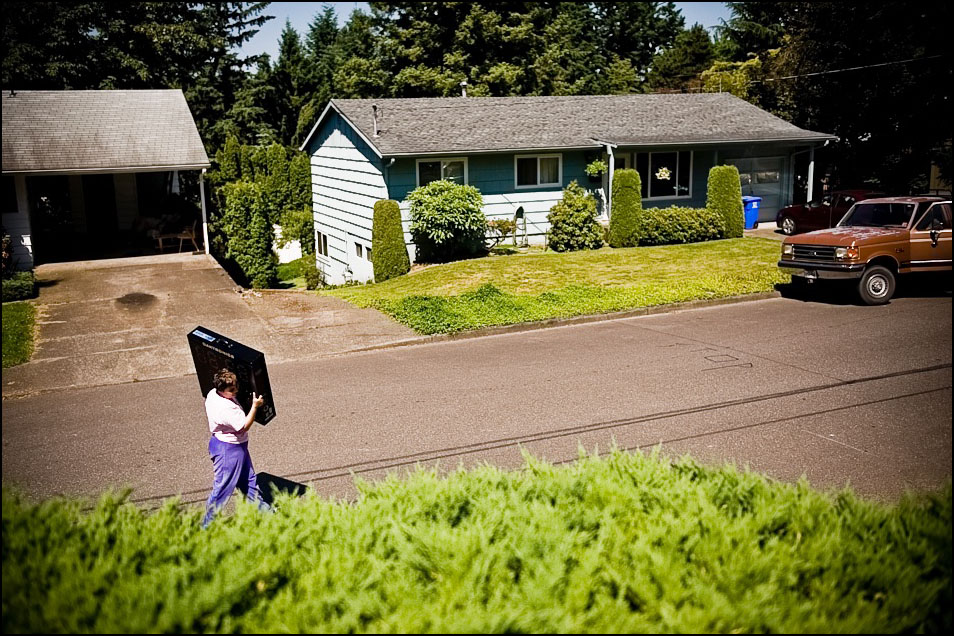
TID:
This is such a unique, intimate situation. Can you tell us
what was going on in your mind during the shoot?
LEAH:
Just that I felt really fortunate to be there. I haven’t been
able to really focus my attention on a long-term project in
a while; as a freelancer I am usually too busy with daily
newspaper and magazine work. That is the one downside
to being self-employed! I ended up getting a Regional Arts
and Culture Council grant (www.RACC.org) to spend a year
on this project and it has been such a gift. When you are
allowed the time to build a connection with people I think
it really shows in the work, that is how intimacy is created.
Plus, some people you just click with, and you know you have
something special. It doesn’t happen with every story or
subject, it is a fleeting, intangible sort of thing. You create
this magical little window of time where you have this
unusual but very connected relationship with someone
that would never exist anywhere else. Look, photographing
somebody’s life, that is a pretty big responsibility, one that
I take incredibly seriously. So during the shoot, I guess I was
feeling the weight of that, and the joy of it too. I could also
feel her getting more and more comfortable with me. This was
a day when she was at her most vulnerable, and she trusted
me with that. Experiences like this are why I became a
documentary photographer.

TID:
Now, lets talk about the image. Tell us what was going on,
and how you made the picture.
LEAH:
The final image was really a summation of the day. Overall,
Anna dealt with the move pretty well, but I could tell she
was feeling raw. Her old room was a cacophony of color and
mementos, and here is this new space, stark and white.
This was when most of the moving had already been done
and it was later in the day. Anna was getting tired and at first
she laid down on her mother’s bed. I made a few pictures
there, first from a distance and then getting more and more
into her personal space. I would say that my approach is pretty
low key. I talk very little when I am shooting, if at all. I always
love images that are made from above when people are sleeping
or in bed, because they really put you right into the story.
I also love them because they conjure images in my mind of
photographers in their bare feet, balancing on wobbly mattresses,
trying not to fall on their subjects! So me being in her personal space,
her feeling sleepy and vulnerable, and the trust that I had built up
with her, all led to the final image. She eventually moved to her room
and to the shot clock. The clock soothes her, it is her friend, and so
naturally that is where she sought solace. It was an unusual situation;
one that I had never encountered before, but I think so much of why
I am allowed access into the private parts of people’s lives is
because of my complete lack of judgment. I come from a place
where I view whatever anyone does as normal. Because, for them,
it is. That is their normality.
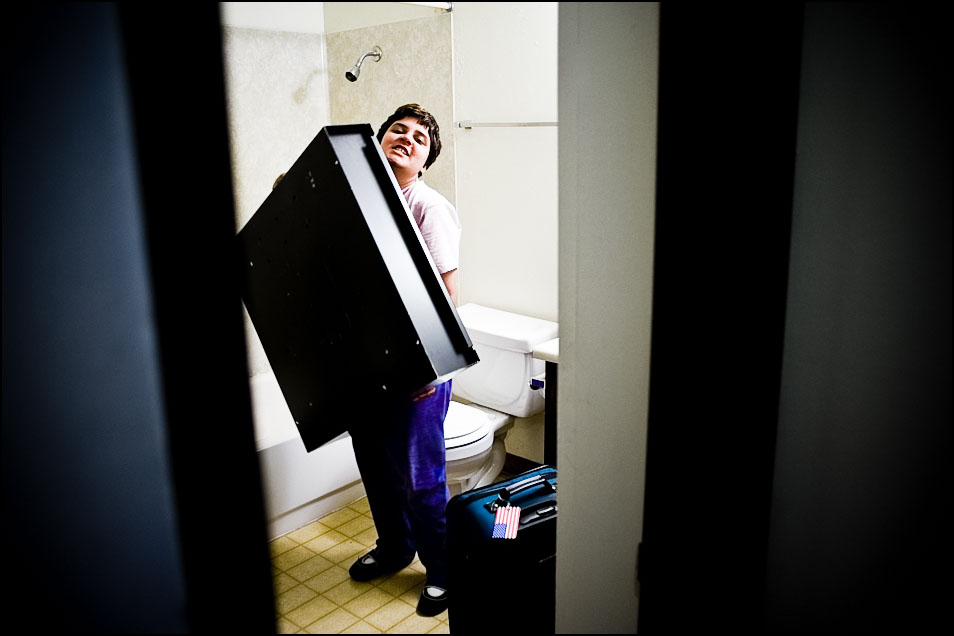
TID:
You said in a previous email:
"She has been bullied a lot over her lifetime because she is
different. Looking at these images I really feel and see a
progression of her getting more and more comfortable with me."
What do you mean by this?
LEAH:
Anna has mentioned several times that growing up and
being with her peers wasn’t the easiest thing for her. She
is different, or neuroatypical, to use the lingo, and high
school students love to crucify those who are different.
What she really wants is respect, and I respect her. I also
give her acceptance and attention; basically, I think she is
cool and interesting. And as a result she feels comfortable
around me, comfortable to be herself, with all the
idiosyncrasies that come with A, being human, and B,
being a human with Asperger’s. That day really seemed
to be a turning point for both of us and I think that is pretty
obvious visually.


TID:
Were there any moments of tension during the making of this
image or the story? If so, how did you handle it?
LEAH:
Photographing a project about Asperger’s is difficult because
everyone who has it experiences it so differently, so you can’t
make generalizations or definitive statements about the syndrome.
Then you have to look at why you are photographing the story.
One of my subject’s therapist told him he thought I was taking
advantage of him, and he and I had to discuss that (at 7 in the
morning). I have to be very careful about how I word things
and what phrasing to use, because many people with Asperger’s
don’t see it as a handicap. The people in the autism community
have a phrase, “Nothing about us, without us,” and so I very
much want this to be a collaborative project. The final published
piece I envision running will have all quotes instead of captions, and
two online pieces will have audio interviews. That way, my biases
can be minimized as much as possible. Even this interview I will
have Anna and her mother look over and approve.
In terms of this image specifically, during the day she and her
mother would sometimes fight or Anna would say something to
embarrass her. But that is just life. When people apologize
because their house isn’t clean or their children are
unruly, I always say, “Hey life is messy, that’s what is so great
about it.”
Shooting her with the clock was definitely a private moment
and I ended up taking a lot of pictures, because I wanted to
have a variety of angles and distances. That way when I was
building the story later I would have options to choose from
that would give visual variety. So it was clearly a moment I
considered important because I was pushing the shutter like
crazy. Anna and I have the understanding that if she doesn’t
want me to shoot anymore, she will tell me and I will stop.
She is good about making her wants and needs known. Better
than most of us, I imagine. Maybe a minute after I took the
final image, she told me she wanted to be alone and I left her
room. This one of the last images I made that day.
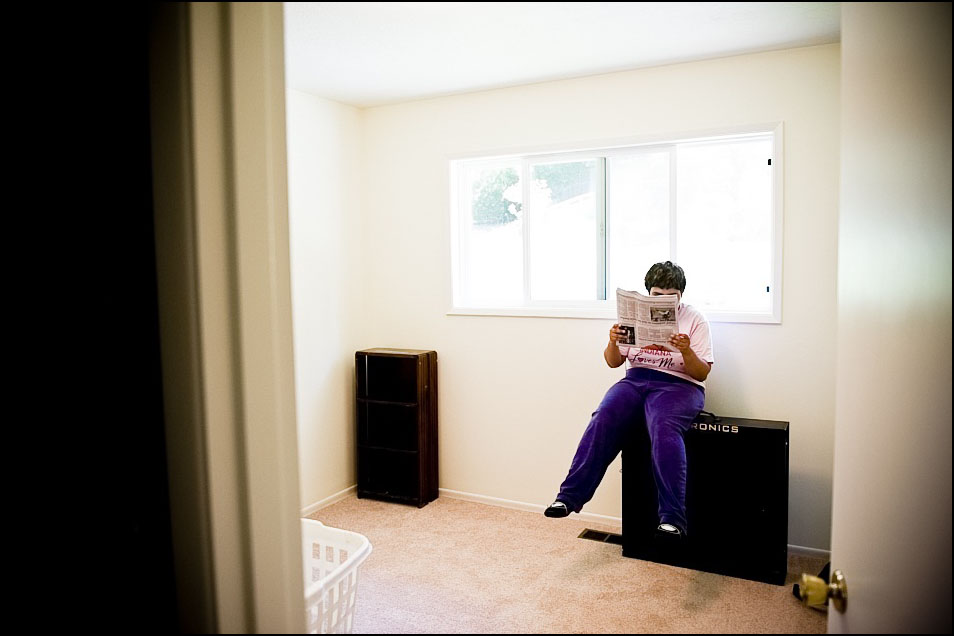
TID:
What surprised you most during this assignment?
LEAH:
I think what surprised me the most was the depth of her
relationship with the shot clock. It is easy to say that people
with Asperger’s fixate on things, but I have been struggling
with HOW to show that. Anna answered that question for
me. This assignment also had made me question societal norms
and really look at how society defines someone as “different.”
Our culture has a very limited, prescribed way we have deemed
appropriate to act and it is so interesting to see how
people respond when someone doesn’t follow that script. In
doing research for this project I spoke to a woman who made
the argument that as a species, we need people with Asperger’s
because they encourage out-of-the-box thinking and help
advance society. Many have made the claim that Einstein
and Issac Newton had Asperger’s, again, because they saw things
differently.
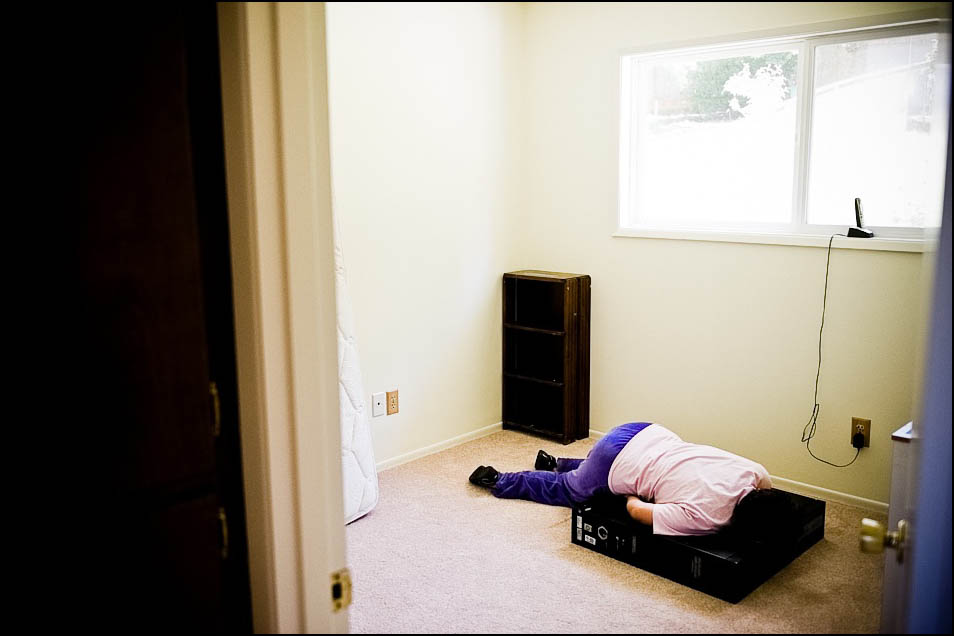
In regard to Anna's relationship with the shot clock, that day her
mother mentioned to me that she used to talk to the one at the
community center near her house. Also, she used to love the
gym floor there, and would lie face down on it, also for comfort
and companionship.
TID:
What did you learn about yourself during the making
of the image/story?
LEAH:
I think it just reminded me rewarding I find long-term
projects, and how difficult they are. I have been lucky
enough to work with photo editor extraordinaire, Mike
Davis (www.Michaelddavis.com) on this project and it
really is invaluable to have a second set of eyes and
someone to push me and my shooting. One of his
suggestions was to have me spend a day shooting no
more than three feet away from my subject! Plus,
I can bounce ideas and thoughts off of him. As a
freelancer, I get very little feedback from clients, and
so I feel lucky to have him on my team.
What this project has also reinforced for me is my belief
that you have to give parts of yourself to your subject;
otherwise, it’s not really a fair trade. And that no matter
how many experiences I have had or how many different
things I have photographed, people can always still surprise
me.
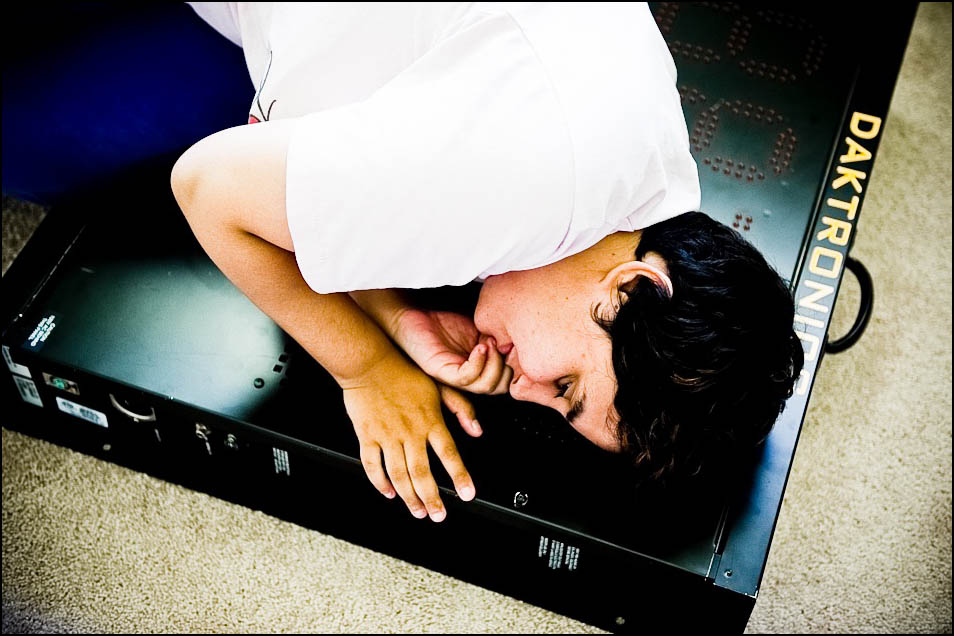
TID:
What mental advice would you have for other photographers
who want to gain access to this type of intimacy?
LEAH:
Leave assumptions and judgment at the door. Make people
want to have you around. Be gracious but persistent. Everyone
works in different ways; you have to find what is authentic
for you. And remember that though you might take pictures
everyday, your subject isn’t photographed everyday, and that
you are leaving a significant footprint.

TID:
What do you want people to know about Bauer, that
you learned from your experience with her?
LEAH:
What I have realized with Anna and with many of the people
with Asperger’s that I have been documenting, is because
they can’t follow social cues, their guards seem to be lowered.
While most of us walk around acting a certain way, pretending
to be a certain way, Anna doesn’t have that. She will tell you
when she wants you to leave, order banana cream pie for dinner,
ride a roller coaster 20 times in a row. There is a certain beauty
in that lack of artifice, in that emotional honesty.
Overall, I just really want people to know her story. To see
what a day in her life is like. I have this crazy idea that
knowledge breeds acceptance and understanding. So if
people get a little insight into Asperger’s, then hopefully
when they meet someone who has it, (or when they realize
that their neighbor, or son, or the guy they work with has it),
then they will be a bit gentler and better equipped to
meet them halfway.

TID:
I was very moved by a letter her mother wrote to you, (see below)
and in conclusion, I wanted to share a part of it. I think it speaks
to your character and your work.
+++
"Your insights about Anna are very moving and accurate. I so
appreciate that you have accepted and understood her. I do
know that she feels that you are a good friend and that she
does feel open around you, as I think the photos reveal. You
have won her heart, which is saying something!....
...If there is anything that Anna and I want to contribute to the
world, it is to have people understand and be supportive of autistic
people. I think Anna is particularly well equipped to do that. She
has been working a lot on her autobiography…maybe she will
show that to you..to help with your captions.
Attached is a little drawing Anna did when she was 14... capturing
her affection and love for scoreboards and of course shot clocks..."
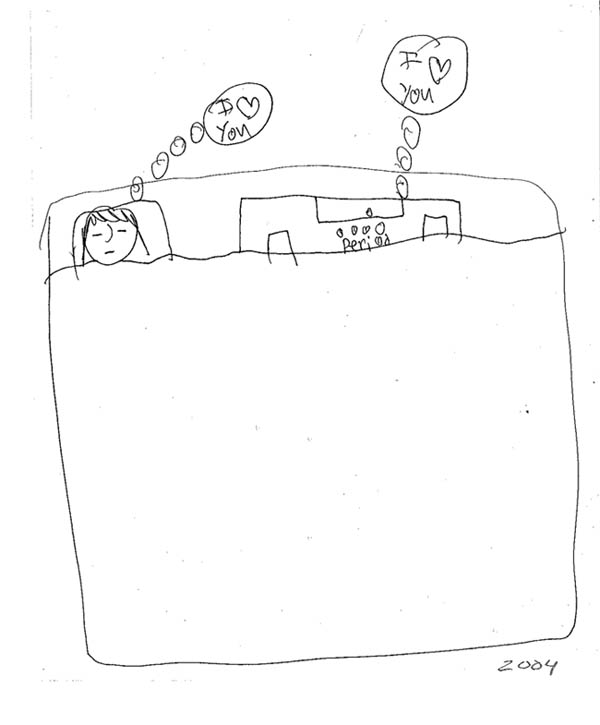
+++++
Leah Nash has a passion for documenting the normal and the extreme, which she often finds are one and the same. Graduating Cum Laude from Vassar College with a degree in psychology she then went on to receive her Master’s in photojournalism at the University of Missouri where she was awarded a Fulbright Grant to photograph the AIDS crisis in India.
Over the years she has received the Marty Forscher Fellowship for Humanistic Photography, the NPPA Kit C. King Scholarship and was named a Magenta Foundation Emerging Photographer. Leah has also been honored by Photo District News, the Eddie Adam’s Workshop and by Pictures of the Year International. Her clients include Newsweek, Rolling Stone, Mother Jones, GEO Magazine, The New York Times, The New York Times Magazine, Der Spiegel, Stern, The Wall Street Journal and The Washington Post.
Recently, she received a Society of Professional Journalists award for her photo essay exploring Asperger’s syndrome and homelessness and in 2011 was given a Regional Arts & Culture Council Grant to expand the project. She is also working on a book entitled, Monogamy?, looking at the viability of monogamy in today’s society and can often be found trailing Pick Up Artists, men who make their living teaching and learning the art of seduction.
Her work can be viewed at:
http://www.LeahNash.com/
http://www.LeahNash.com/blog
+++++
Next week we'll feature this powerful image by Nick Oza:
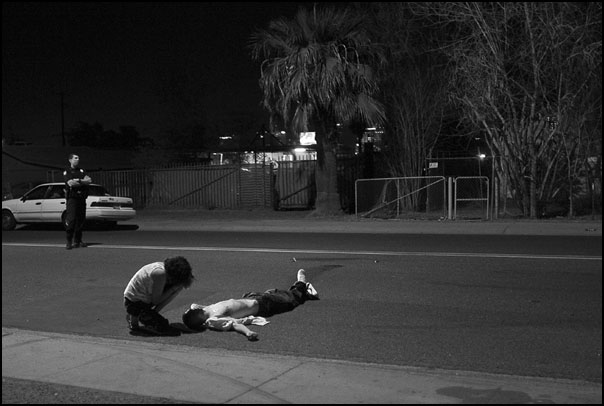
As always, if you have a suggestion of someone, or an image you
want to know more about, contact Ross Taylor or Logan Mock-Bunting:
[email protected]
[email protected]
For FAQ about the blog see here:
http://www.imagedeconstructed.com/